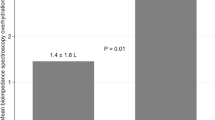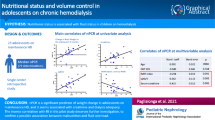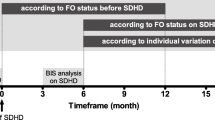Abstract
Purpose
The ability to maintain sodium and water homeostasis is impaired in patients with end-stage renal disease (ESRD), leading to hyponatremia and fluid overload. The aim of this study was to evaluate the association between serum sodium level and body fluid status in patients on maintenance hemodialysis (HD).
Methods
This was a prospective observational study on patients with ESRD and who were on maintenance HD between June and November 2018. Assessment of body fluid status using bioimpedance spectroscopy and measurement of serum sodium level were conducted simultaneously predialysis. The association of fluid status with predialysis sodium level was analyzed.
Results
Sixty-two patients were enrolled in the study group. Compared with patients with predialysis normonatremia, those with predialysis hyponatremia had higher levels of blood urea nitrogen, serum potassium, phosphate, normalized protein catabolic rate, and interdialytic weight gain (IDWG) (p < 0.05). The correlations of predialysis sodium level with chronic fluid status, such as fluid overload, were not significant. Logistic regression analysis found significant association of IDWG with predialysis hyponatremia.
Conclusion
Predialysis hyponatremia was associated with increased IDWG. The substantial variation in serum sodium levels, regardless of fluid status, indicated the complex relationship between sodium and water balance in patients on maintenance HD.

Similar content being viewed by others
References
Hoorn EJ, Zietse R (2013) Hyponatremia and mortality: moving beyond associations. Am J Kidney Dis 62(1):139–149. https://doi.org/10.1053/j.ajkd.2012.09.019
Rhee CM, Ravel VA, Ayus JC, Sim JJ, Streja E, Mehrotra R, Amin AN, Nguyen DV, Brunelli SM, Kovesdy CP, Kalantar-Zadeh K (2016) Pre-dialysis serum sodium and mortality in a national incident hemodialysis cohort. Nephrol Dial Transplant 31(6):992–1001. https://doi.org/10.1093/ndt/gfv341
Zevallos G, Oreopoulos DG, Halperin ML (2001) Hyponatremia in patients undergoing CAPD: role of water gain and/or malnutrition. Perit Dial Int 21(1):72–76
Hsiao PJ, Liao CY, Kao YH, Chan JS, Lin YF, Chuu CP, Chen JS (2020) Comparison of fractional excretion of electrolytes in patients at different stages of chronic kidney disease: a cross-sectional study. Medicine (Baltimore) 99(2):e18709. https://doi.org/10.1097/MD.0000000000018709
Combs S, Berl T (2014) Dysnatremias in patients with kidney disease. Am J Kidney Dis 63(2):294–303. https://doi.org/10.1053/j.ajkd.2013.09.017
Canaud B, Kooman J, Selby NM, Taal M, Francis S, Kopperschmidt P, Maierhofer A, Kotanko P, Titze J (2019) Sodium and water handling during hemodialysis: new pathophysiologic insights and management approaches for improving outcomes in end-stage kidney disease. Kidney Int 95(2):296–309. https://doi.org/10.1016/j.kint.2018.09.024
Hecking M, Kainz A, Horl WH, Herkner H, Sunder-Plassmann G (2011) Sodium setpoint and sodium gradient: influence on plasma sodium change and weight gain. Am J Nephrol 33(1):39–48. https://doi.org/10.1159/000322572
Cooper BA, Aslani A, Ryan M, Zhu FY, Ibels LS, Allen BJ, Pollock CA (2000) Comparing different methods of assessing body composition in end-stage renal failure. Kidney Int 58(1):408–416. https://doi.org/10.1046/j.1523-1755.2000.00180.x
Hecking M, Karaboyas A, Antlanger M, Saran R, Wizemann V, Chazot C, Rayner H, Horl WH, Pisoni RL, Robinson BM, Sunder-Plassmann G, Moissl U, Kotanko P, Levin NW, Saemann MD, Kalantar-Zadeh K, Port FK, Wabel P (2013) Significance of interdialytic weight gain versus chronic volume overload: consensus opinion. Am J Nephrol 38(1):78–90. https://doi.org/10.1159/000353104
Albalate Ramon M, de Sequera OP, Perez-Garcia R, Ruiz-Alvarez MJ, Corchete Prats E, Talavan T, Alcazar Arroyo R, Puerta Carretero M, Ortega-Diaz M (2013) Sodium set-point in haemodialysis: is it what we see clinically? Nefrologia 33(6):808–815. https://doi.org/10.3265/Nefrologia.pre2013.Sep.12117
Katz MA (1973) Hyperglycemia-induced hyponatremia—calculation of expected serum sodium depression. N Engl J Med 289(16):843–844. https://doi.org/10.1056/NEJM197310182891607
Daugirdas JT (1993) Second generation logarithmic estimates of single-pool variable volume Kt/V: an analysis of error. J Am Soc Nephrol 4(5):1205–1213
Moissl UM, Wabel P, Chamney PW, Bosaeus I, Levin NW, Bosy-Westphal A, Korth O, Muller MJ, Ellegard L, Malmros V, Kaitwatcharachai C, Kuhlmann MK, Zhu F, Fuller NJ (2006) Body fluid volume determination via body composition spectroscopy in health and disease. Physiol Meas 27(9):921–933. https://doi.org/10.1088/0967-3334/27/9/012
Hung SC, Kuo KL, Peng CH, Wu CH, Lien YC, Wang YC, Tarng DC (2014) Volume overload correlates with cardiovascular risk factors in patients with chronic kidney disease. Kidney Int 85(3):703–709. https://doi.org/10.1038/ki.2013.336
Chamney PW, Wabel P, Moissl UM, Muller MJ, Bosy-Westphal A, Korth O, Fuller NJ (2007) A whole-body model to distinguish excess fluid from the hydration of major body tissues. Am J Clin Nutr 85(1):80–89. https://doi.org/10.1093/ajcn/85.1.80
Passauer J, Petrov H, Schleser A, Leicht J, Pucalka K (2010) Evaluation of clinical dry weight assessment in haemodialysis patients using bioimpedance spectroscopy: a cross-sectional study. Nephrol Dial Transplant 25(2):545–551. https://doi.org/10.1093/ndt/gfp517
Waikar SS, Curhan GC, Brunelli SM (2011) Mortality associated with low serum sodium concentration in maintenance hemodialysis. Am J Med 124(1):77–84. https://doi.org/10.1016/j.amjmed.2010.07.029
Wizemann V, Wabel P, Chamney P, Zaluska W, Moissl U, Rode C, Malecka-Masalska T, Marcelli D (2009) The mortality risk of overhydration in haemodialysis patients. Nephrol Dial Transplant 24(5):1574–1579. https://doi.org/10.1093/ndt/gfn707
Wang Z, Deurenberg P, Wang W, Pietrobelli A, Baumgartner RN, Heymsfield SB (1999) Hydration of fat-free body mass: review and critique of a classic body-composition constant. Am J Clin Nutr 69(5):833–841. https://doi.org/10.1093/ajcn/69.5.833
Fisch BJ, Spiegel DM (1996) Assessment of excess fluid distribution in chronic hemodialysis patients using bioimpedance spectroscopy. Kidney Int 49(4):1105–1109. https://doi.org/10.1038/ki.1996.160
Brennan BL, Yasumura S, Letteri JM, Cohn SH (1980) Total body electrolyte composition and distribution of body water in uremia. Kidney Int 17(3):364–371. https://doi.org/10.1038/ki.1980.42
Zoccali C, Moissl U, Chazot C, Mallamaci F, Tripepi G, Arkossy O, Wabel P, Stuard S (2017) Chronic fluid overload and mortality in ESRD. J Am Soc Nephrol 28(8):2491–2497. https://doi.org/10.1681/ASN.2016121341
Cherney DZ, Zevallos G, Oreopoulos D, Halperin ML (2001) A physiological analysis of hyponatremia: implications for patients on peritoneal dialysis. Perit Dial Int 21(1):7–13
Hecking M, Karaboyas A, Saran R, Sen A, Horl WH, Pisoni RL, Robinson BM, Sunder-Plassmann G, Port FK (2012) Predialysis serum sodium level, dialysate sodium, and mortality in maintenance hemodialysis patients: the Dialysis Outcomes and Practice Patterns Study (DOPPS). Am J Kidney Dis 59(2):238–248. https://doi.org/10.1053/j.ajkd.2011.07.013
Mc Causland FR, Brunelli SM, Waikar SS (2012) Dialysate sodium, serum sodium and mortality in maintenance hemodialysis. Nephrol Dial Transplant 27(4):1613–1618. https://doi.org/10.1093/ndt/gfr497
Hecking M, Karaboyas A, Saran R, Sen A, Inaba M, Rayner H, Horl WH, Pisoni RL, Robinson BM, Sunder-Plassmann G, Port FK (2012) Dialysate sodium concentration and the association with interdialytic weight gain, hospitalization, and mortality. Clin J Am Soc Nephrol 7(1):92–100. https://doi.org/10.2215/CJN.05440611
Kayikcioglu M, Tumuklu M, Ozkahya M, Ozdogan O, Asci G, Duman S, Toz H, Can LH, Basci A, Ok E (2009) The benefit of salt restriction in the treatment of end-stage renal disease by haemodialysis. Nephrol Dial Transplant 24(3):956–962. https://doi.org/10.1093/ndt/gfn599
Thijssen S, Raimann JG, Usvyat LA, Levin NW, Kotanko P (2011) The evils of intradialytic sodium loading. Contrib Nephrol 171:84–91. https://doi.org/10.1159/000327333
Ifudu O, Dulin AL, Friedman EA (1994) Interdialytic weight gain correlates with glycosylated hemoglobin in diabetic hemodialysis patients. Am J Kidney Dis 23(5):686–691. https://doi.org/10.1016/s0272-6386(12)70279-2
Perez-Garcia R, Palomares I, Merello JI, Ramos R, Maduell F, Molina M, Aljama P, Marcelli D, Group ORD (2016) Hyponatraemia, mortality and haemodialysis: an unexplained association. Nefrologia 36(1):42–50. https://doi.org/10.1016/j.nefro.2015.10.005
Wabel P, Moissl U, Chamney P, Jirka T, Machek P, Ponce P, Taborsky P, Tetta C, Velasco N, Vlasak J, Zaluska W, Wizemann V (2008) Towards improved cardiovascular management: the necessity of combining blood pressure and fluid overload. Nephrol Dial Transplant 23(9):2965–2971. https://doi.org/10.1093/ndt/gfn228
Dekker MJ, Marcelli D, Canaud B, Konings CJ, Leunissen KM, Levin NW, Carioni P, Maheshwari V, Raimann JG, van der Sande FM, Usvyat LA, Kotanko P, Kooman JP (2016) Unraveling the relationship between mortality, hyponatremia, inflammation and malnutrition in hemodialysis patients: results from the international MONDO initiative. Eur J Clin Nutr 70(7):779–784. https://doi.org/10.1038/ejcn.2016.49
Funding
This study was supported in part by a grant from the Armed Forces Taoyuan General Hospital (AFTYGH-10711).
Author information
Authors and Affiliations
Contributions
All authors contributed to the study conception and design. Material preparation, data collection, and analysis were performed by W-FC, P-JH and K-LW. The first draft of the manuscript was written by W-FC and all authors commented on previous versions of the manuscript. All authors read and approved the final manuscript.
Corresponding author
Ethics declarations
Conflict of interest
The authors declare that they have no conflict of interest.
Ethics approval
The study was performed in accordance with Declaration of Helsinki guidelines on the ethical principles for medical research involving human subjects and was approved by the Institutional Review Board of the Tri-Service General Hospital (TSGHIRB No. 1-107-05-034).
Consent
Informed consent was obtained from all individual participants included in the study.
Additional information
Publisher's Note
Springer Nature remains neutral with regard to jurisdictional claims in published maps and institutional affiliations.
Rights and permissions
About this article
Cite this article
Chiang, WF., Hsiao, PJ., Wu, KL. et al. Association of predialysis serum sodium level with fluid status in patients on maintenance hemodialysis. Int Urol Nephrol 52, 1571–1579 (2020). https://doi.org/10.1007/s11255-020-02521-y
Received:
Accepted:
Published:
Issue Date:
DOI: https://doi.org/10.1007/s11255-020-02521-y




